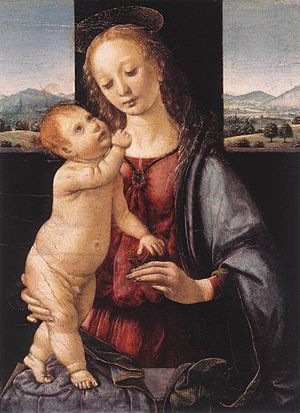Madonna Dreyfus

|
| Mary with the child and a pomegranate (Madonna Dreyfus) |
|---|
| Lorenzo di Credi , around 1475–1480 |
| oil on wood |
| 15.7 x 12.8 cm |
| National Gallery of Art , Washington DC |
The Madonna Dreyfus is an important picture of the Madonna of the Italian Renaissance by Lorenzo di Credi from an art-historical point of view .
History and controversy
The picture of Mary with the child and a pomegranate has generally gone down in art history as Madonna Dreyfus after its owner for many years . The picture from the school of Andrea del Verrocchio is now attributed to Lorenzo di Credi , who was stylistically based on Leonardo da Vinci . An earlier identification as the work of Leonardo is now considered false.
The picture only became known when it was in the possession of the well-known Parisian art collector Gustave Dreyfus . In 1930 it was sold by his heirs and was in the art trade of Duveen Brothers, Inc. in London and New York for several years . From there it was acquired by the Samuel H. Kress Foundation in 1951, which donated it to the National Gallery of Art in Washington in 1952 .
Since its discovery, the picture has been attributed first to Verrocchio himself and then, in the absence of known autograph works, to Lorenzo di Credi. However, it was pointed out from the beginning that the picture is far beyond what Lorenzo di Credi was able to create. It shows such smooth transitions in the colors and contours and such soft shadows that you cannot find on any of his other pictures. In 1929 Wilhelm Suida suggested Leonardo as the author of the picture for the first time and in 1932 found support from Bernard Degenhart .
Nevertheless, art history remained divided in the period that followed. Bernard Berenson thought the picture (1938) was a work by Lorenzo di Credi, who tried to imitate Leonardo. Many other art historians followed this ascription. John Shearman, on the other hand, judged the picture (1967) to be an autograph work by Verrocchio and saw a drawing in the Dresden Kupferstichkabinett as an autograph study for it. Günter Passavant (1969) judged the painting only as a work of the Verrocchio workshop, but also considered Lorenzo di Credi's authorship to be possible. Accordingly, for a long time the picture was only referred to as coming from the workshop of Verrocchio in a neutral manner, before the National Gallery of Art in Washington decided to catalog it again as a work by Lorenzo di Credi and to exhibit it to this day.
Regardless of this, a large part of modern art history is increasingly tending to regard the picture as an early handwritten work by Leonardo da Vinci. In 1968 Sheldon Grossman stated that the picture is a copy of a lost work by Lorenzo di Credi, which was painted according to a design by Leonardo. But in the same year it was attributed to Leonardo himself by Raymond Somers Stites . The joined, among others, Carlo Ragghianti (1975) and Pietro C. Marani (1989 and 1999) on.
Jack Wasserman (1975), on the other hand, only ascribes to Leonardo the invention of the picture, and Piero Adorno (1991) also considers it only a workshop work from Verrocchio's studio, on which perhaps with a view to the poorly painted child and the better Maria two different students have worked. A similar assessment is made today of the adoration of the child with two angels in Detroit ( Art Institute ), in which some researchers also assume the participation of Leonardo for individual parts.
In addition to the unsuccessful child, the lack of the fingerprints typical of Leonardo is certainly a main argument against his authorship. Marani explains this with an old, undocumented cleaning of the picture, during which this could have been lost. Today the owner, the National Gallery of Art in Washington DC, clearly attributes it to di Credi.
The time when the picture was created is controversial. Passavant assumes that it must have been painted later than the Madonna with the Carnation . Wasserman puts it at the same time. Marani moves it closer to the time of the Annunciation in the Uffizi Gallery in Florence , where he sees technical similarities in painting. He also recognizes Venetian influences, which he explains with the fact that Leonardo accompanied Verrocchio on his trip to Venice in 1469 .
literature
- Wilhelm Suida: Leonardo and his circle , 1929, Verlag F. Bruckmann A.-G. (Munich)
- Maria Pomilio / Angela Ottino Della Chiesa: Classics of Art - Leonardo da Vinci , 1967, Kunstkreis Luzern - Freudenstadt - Vienna
- Pietro C. Marani: Leonardo , 1989, Cantini (Florence) ISBN 88-7737-046-7
- Franziska Windt, Andrea del Verrocchio and Leonardo da Vinci - Cooperation in Sculpture and Painting , Münster, 2003, ISBN 3-930454-39-4
- Serge Bramly: Léonard de Vinci , Jean-Claude Lattès, Paris, 1988
- Brigitte Labbé, Michel Puech, Jean-Pierre Joblin: Léonard de Vinci . - Toulouse : Milan jeunesse, coll. "De vie en vie" n ° 18, 2005 . - 58 p., 18 cm. - ISBN 2-7459-1631-9 .
